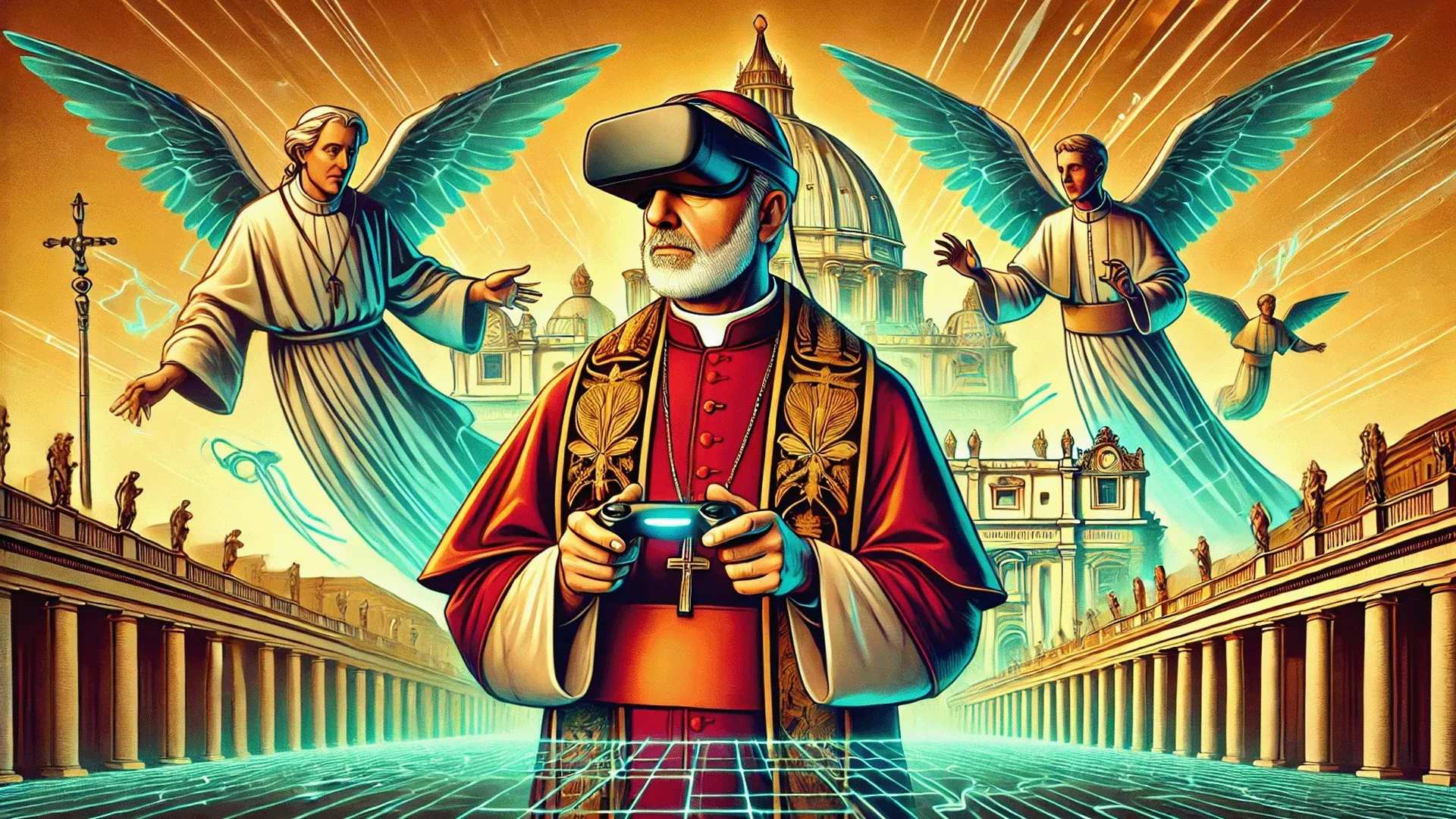A Blend of Tradition and Technology In an unprecedented convergence of faith, culture, and technology, the Vatican has opened its doors to a cu
A Blend of Tradition and Technology
In an unprecedented convergence of faith, culture, and technology, the Vatican has opened its doors to a cutting-edge art exhibit that merges centuries-old religious traditions with the marvels of artificial intelligence. The “Interconnected Hearts: Taiwan Contemporary Art Exhibition 2024” is now on display at the Republic of China’s Embassy to the Holy See, situated near St. Peter’s Square. This exhibit is a key part of the 2025 Jubilee Year and marks a significant moment in the Church’s exploration of technology’s role in faith and culture.
Catholic cardinals, including the venerable 84-year-old Cardinal Silvano Maria Tomasi and the esteemed Cardinal José Tolentino de Mendonça, were among the first to experience this innovative showcase through virtual reality (VR) headsets. The exhibit, crafted by Taiwanese artists and utilizing a blend of 3D scanning, VR, and machine learning, is a powerful testament to the creative potential harnessed by AI.
A Modern Canvas: The Significance of the Exhibition
The “Interconnected Hearts” exhibit does more than just showcase art—it symbolizes the evolving relationship between spirituality and technology. Taiwan’s Embassy to the Holy See has positioned the exhibit as an exploration of how AI can amplify human creativity, resonating deeply with the Vatican’s broader dialogue on the ethical implications of artificial intelligence.
Cardinal Tolentino, the Vatican’s prefect of the Dicastery for Culture and Education, expressed awe at the exhibit, praising it as “intriguing and extremely innovative.” His statement underscores a broader recognition within the Church that technology, when aligned with ethical principles, can serve as a bridge between diverse cultural and spiritual experiences.
Immersive Experience: Cardinals Embrace Virtual Reality
At the heart of the exhibit are VR headsets provided by META, which transport viewers into a digitally constructed world where Taiwanese and Vatican architectural motifs blend seamlessly. One particularly notable piece by artist Hung Yu Hao allows users to witness the convergence of Taiwan’s intricate temples and the grandeur of St. Peter’s Square in a shared virtual space.
For Cardinal Tomasi, known for his deep understanding of diplomacy and social issues, the VR experience was a reminder of how art and technology can be tools for fostering global understanding. His participation highlights the Vatican’s openness to technological innovation, a sentiment echoed by Ambassador Matthew Lee, who lauded Taiwan’s position as a leader in AI technology and human resource development.
Taiwan’s Vision: An AI-Powered Future
Ambassador Lee’s words during the opening ceremony were more than a reflection of national pride; they were a statement of intent. Taiwan’s President Lai Ching-te has made it clear that the island is poised to become an “AI Island,” blending technology with culture to foster a unique national identity. The exhibit’s inclusion on the Jubilee’s official cultural calendar by the Dicastery for Evangelization solidifies Taiwan’s role in shaping the dialogue around technology and faith.
The exhibit’s title, “心信相連”, meaning “Hearts Connected by Faith,” beautifully encapsulates the exhibit’s mission. It emphasizes the shared spiritual values that connect believers worldwide, merging ancient religious devotion with contemporary artistic expression.
A Testament to Human-AI Collaboration
The works displayed at the exhibition are examples of human and AI collaboration. One standout piece is a 3D-printed installation that symbolizes the partnership between machine learning algorithms and human creativity. During the opening event, an artist from Taiwan detailed how AI’s role was not to overshadow human effort but to act as an instrument that refines and enhances artistic expression.
Cardinal Tolentino’s observations about the exhibition being a result of “the creativity of human genius, enhanced by the use of artificial intelligence” mirror the Vatican’s cautious but hopeful stance on technology. The Church remains vigilant about the ethical deployment of AI, a point underscored by Pope Francis in his message for the World Day for Peace 2024 and his address to the G7.
Ethical Reflections and the Church’s Responsibility
The Vatican has taken a proactive approach in discussing AI’s ethical implications, ensuring it serves humanity and upholds dignity. Cardinal Tolentino pointed out that this “new magnificent tool” must always remain at the service of those most in need, never evolving into a mechanism of oppression or dominance.
Check out how Camu Camu can benefit your daily health, click here to find more.
The theme of responsibility is especially pertinent in an era where technology can both liberate and marginalize. Tolentino’s statement, “Only in this way will we humans affirm and strengthen our humanity,” captures the Church’s commitment to ensuring that technological advancements contribute positively to society.
High-Tech Partnerships: The Vatican and Microsoft
Complementing the exhibit’s innovative use of VR was another high-profile technological collaboration between the Vatican and Microsoft. Earlier this week, Brad Smith, Microsoft’s Vice Chair and President, presented a 3D digital model of St. Peter’s Basilica. This model, created with the help of advanced AI algorithms, offers a comprehensive, virtual exploration of the historic site and its treasures to users around the world.
Smith described the project as “one of the most technologically advanced and sophisticated projects of its kind,” reinforcing the idea that partnerships between the Vatican and tech giants could yield groundbreaking tools for education and engagement.
The Future of Faith and Technology
As the Vatican forges ahead with initiatives that marry tradition and technological advancement, the “Interconnected Hearts” exhibit stands as a symbol of progress and possibility. It invites viewers to ponder deeper questions: How can faith communities leverage AI without compromising core values? What role should religious institutions play in guiding ethical discussions around emerging technologies?
While the Church is known for its adherence to tradition, this exhibit and the Vatican’s embrace of VR signify a willingness to engage in forward-thinking dialogues that bridge the past with the future. The participation of cardinals in such events not only adds gravitas but also highlights the Church’s ongoing effort to stay relevant in an age defined by rapid technological change.
Conclusion: A Milestone in Religious and Cultural Innovation
The “Interconnected Hearts: Taiwan Contemporary Art Exhibition 2024” is more than just an art display—it is a milestone in religious and cultural innovation. It challenges the notion that technology and spirituality exist in separate realms and demonstrates that, under ethical stewardship, AI can deepen human connection and enhance the artistic experience.
The exhibit’s success and the positive reception from high-ranking Vatican officials set a precedent for future explorations into how faith can coexist and evolve alongside technology. The seamless blend of VR, art, and religious contemplation at this exhibit invites the faithful and the curious alike to see the world through a new, technologically enhanced lens.
Check out how Camu Camu can benefit your daily health, click here to find more.


